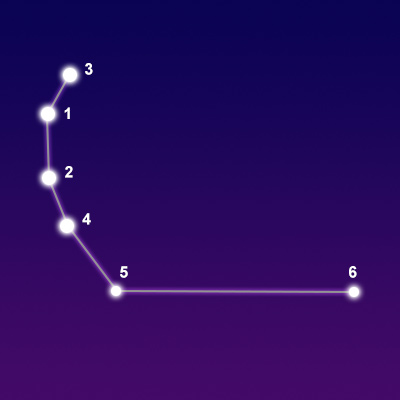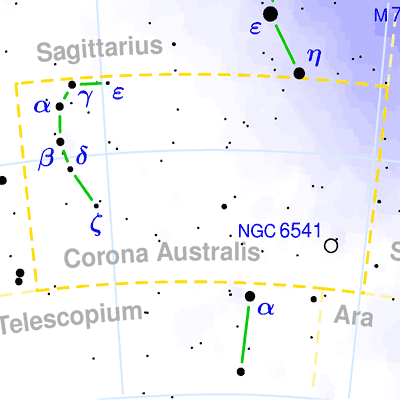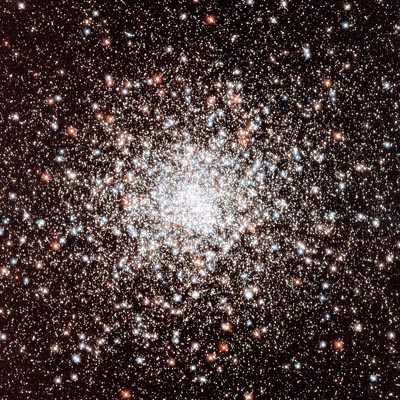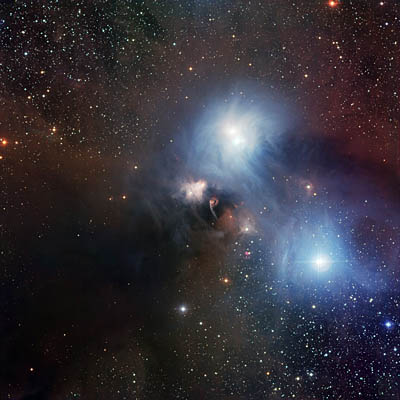Pronunciation:
(koh-ROH-nuh ahs-TRAY-liss)Abbreviation:
CrAGenitive:
Coronae AustralisRight Ascension:
19 hoursDeclination:
-40 degreesArea in Square Degrees:
128Crosses Meridian:
9 PM, August 15Visible Between Latitudes:
40 and -90 degreesThe constellation Corona Australis, the southern crown, is located in the southern hemisphere of the sky. Known as the Southern Crown, it is visible from latitudes south of 44 degrees from May through July. It can best be seen in the northern hemisphere in August, although it is completely below the horizon at latitudes north of 50 degrees. It is a small constellation occupying 128 square degrees of the sky. It ranks 80th in size among the 88 constellations in the night sky. It is bordered by Sagittarius to the north, Scorpius to the west, Telescopium to the south, and Ara to the southwest.
Corona Australis is one of the 48 constellations cataloged by the Greek astronomer Ptolemy in the second century. Its name means “southern crown” in Latin. It is an ancient constellation with roots in many cultures. It has been represented as a turtle, an ostrich nest, and even a tent. To the ancient Greeks, it represented a wreath. It was also seen as a circlet of stars near the feet of the centaur represented by the constellation Sagittarius. It is sometimes associated with the myth of Dionysus. In this myth, the stars represent the crown the god placed in the sky after freeing his mother Semele from Hades. This myth is also sometimes associated with Corona Borealis, the constellation of the Northern Crown.

common points of interest below © Sea and Sky

© Torsten Bronger CC BY-SA 3.0
Beta Coronae Australis
Gamma Coronae Australis
Delta Coronae Australis
Zeta Coronae Australis
Theta Coronae Australis
N/A
N/A
N/A
N/A
N/A
Orange Giant Star
Binary Star System
Orange Giant Star
Blue-White Subdwarf Star
Yellow Giant Star
4.12
4.20
4.58
4.75
4.64
Corona Australis is an extremely dim constellation with no stars brighter than magnitude 4. The brightest star is Alfecca Maridiana with a visual magnitude of 4.11. It is a blue subgiant star located approximately 130 light years from Earth. The second brightest star is Beta Coronae Australis with a magnitude of 4.12. It is an orange giant star that lies about 510 light years away. The third brightest star is Gamma Coronae Australis with a magnitude of 4.20. It is a binary star system located some 56 light years from Earth.
Corona Australis contains no Messier objects but does contain a few notable deep-sky objects. The Corona Australis Nebula is a bright reflection nebula formed by bright stars surrounded by a dark cloud of dust. It is an area where new stars are being formed. The Coronet Cluster is an open star cluster surrounded by gas and dust. It is one of the closest known regions of star formation. NGC 6541 is a globular star cluster that is estimated to be around 12.9 billion years old. NGC 6729 is a reflection/emission nebula near the star Zeta Sagittarii. None of these objects can be seen without the aid of a large telescope.

by the Hubble Space Telescope

© European Southern Observatory / CC BY 3.0



